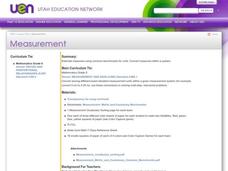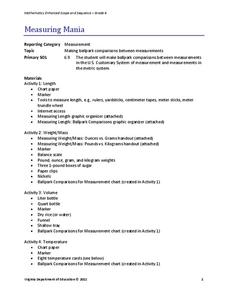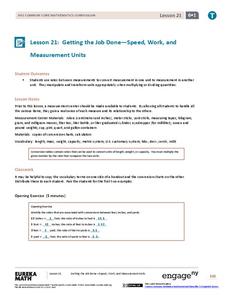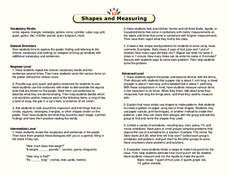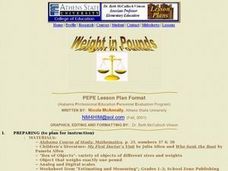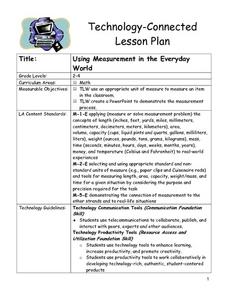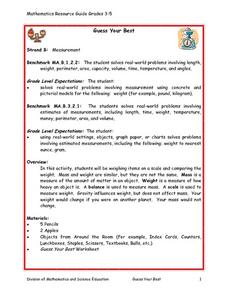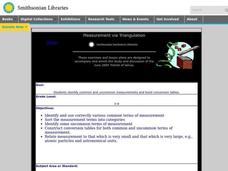Curated OER
By the Pound
Agriculture surrounds us every day; incorporate measuring tools into a study of Oklahoma's agricultural industry! Small groups read an informational text (included) before visiting stations where they investigate prices of various...
Curated OER
Back To the Basics: Measurement
Lead the class in a review of the basic concepts and procedures involved in measuring length, weight, and volume. After whole group instruction, small groups and individuals practice measuring by completing a variety of fun activities...
Curated OER
Measurement
Students explore the concept of measurement. In this measurement lesson, students discuss what specific measurement tools such as an odometer measure. Students recite a measurement poem. Students make a foldable with conversion units...
Virginia Department of Education
Measuring Mania
Conversion immersion — it's measuring mania! A set of four activities teaches scholars to convert between customary and metric units. Resource covers unit conversions in length, temperature, weight/mass, and volume.
EngageNY
Getting the Job Done—Speed, Work, and Measurement Units
How do you convert from one measurement to another? Pupils use unit rates to convert measurements from one unit to another in the 21st segment in a 29-part series. They convert within the same system to solve length, capacity,...
Curated OER
Converting Measurements
Sixth graders convert customary linear measurements. They explore using ratios to convert from inches to feet, ounces to pounds, etc. In groups, 6th graders complete conversions. They explain to the class how to solve their problems.
Curated OER
Measure Mania
Groups of learners rotate through five classroom stations to estimate, measure, and record volume, length, weight, mass, and area using both customary and metric measure. They evaluate their data to determine how close their estimates...
Houghton Mifflin Harcourt
Shapes and Measuring
Youngsters develop mathematical vocabulary with this worksheet. First, give youngsters time to identify their vocabulary words in the picture provided. Then, as a group, practice saying the vocabulary words aloud. Finally, have learners...
Alabama Learning Exchange
Cosmic Measurements
Students develop two units of measurement to relate to the astronomical unit and the light year. In this astronomy instructional activity, students use a Twizzler to develop a measurement unit similar to the astronomical unit. They use a...
Curated OER
Mass, Volume, and Weight
Students explore mass, volume, and weight. In this science and measurement lesson, students compare volume, mass, and weight after listening to the teacher's description of each. Students explore different scales and balances and...
Curated OER
How Much is a Pound? A Weight Lesson
Fourth graders explore weight in pounds. In this measurement instructional activity, students estimate the weight of teacher-provided objects, measure the actual weight of the objects using scales, and discuss food products sold by the...
Curated OER
Weights in Pounds
Second graders define "pound," estimate and compare weights, and classify objects as weighing more or less than a pound.
Curated OER
Measurement: Lesson 3
Eighth graders investigate the concepts that are related to measurement while focusing upon weight, mass, and capacity. They estimate the weight and mass relationship that is found in different problems. Students compare and contrast one...
Curated OER
Using Measurement in the Everyday World
Students use an appropriate unit of measure to measure an item in the classroom. They create a PowerPoint to demonstrate the measurement process. Pupils are divided into pairs. Students use a concept map to discuss the terms for...
Curated OER
Measuring Weight
Students use tables showing the ratios between ounces and pounds, grams and kilograms, and pounds and kilograms. They estimate whether an object should be weighed in ounces or pounds and whether an object should be weighed in grams or...
Curated OER
Weight
Third graders select appropriate units for measuring and solving problems in customary systems, identify equivalent measures within measurement system, and estimate, determine, record, and discuss weight using appropriate customary...
Curated OER
Relative Weight
Second graders distinguish the difference between pounds and ounces and arrange manipulatives from heaviest to lightest.
Curated OER
Computing With Customary Units
In this mathematics worksheet, 6th graders identify and practice adding and subtracting units of measure. They add or subtract and regroup for each problem. Then, students explain how each way is different.
Curated OER
"How Do You Measure Up?"
Fourth graders explore basic measurements by analyzing their own bodies. In this human anatomy activity, 4th graders identify the units used to measure a human body such as centimeters, inches, ounces and pounds. Students complete a...
Curated OER
Guess Your Best
Learners discuss situations when it is useful to know exact weight of object as opposed to estimated weight, estimate weight of various items, weigh them on scale using ounces and pounds, and compare their weights on Guess Your Best...
Curated OER
Bison Eating
Fifth graders use metric measurement to study the amount a bison eats. In this measurement activity, 5th graders watch a video about bison and discuss the amount of food they eat. Students weigh their food trays at lunch and complete a...
Curated OER
Grams and Kilograms
Fourth graders participate in scavenger hunts for objects that weigh a gram and a kilogram. In this metric measure lesson, 4th graders use a spring scale to measure objects they believe weigh a gram and a kilogram. Students complete...
Curated OER
Pounds and Ounces: It's All About Weight
First graders explore number sense by participating in a measurement estimation activity. In this weight lesson, 1st graders discuss the differences between measurement units, both English and Metric. Students examine a loaf of bread to...
Curated OER
Measurement Via Triangulation
Students investigate various common terms of measurement, sort them into categories, select the uncommon terms, and construct conversion tables for both the common and the uncommon terms of measurement.


